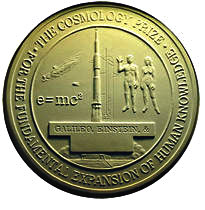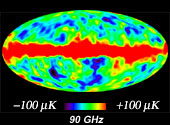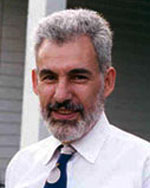 |
 |
 |
 |
 |
 |
 |
 |
 |
 |
|
KICP News
|
KICP News, 2006
Public Cosmology Panel Discussion: New Views of the Universe January 20, 2006  What is the nature of the mysterious Dark Energy that is speeding up the expansion of the universe? Are there Extra Dimensions beyond the three we know about? Do Parallel Universes or Multiverses exist? A music and dance theater may seem an unlikely place to see cosmologists up on the stage. However, on Monday December 12, 2005 one thousand peopled crowded the Harris Theater in Millennium Park to hear four of the world's leading cosmologists and National Public Radio's Ira Flatow discuss and debate the earliest moments after the Big Bang, Dark Energy, Extra Dimensions, and Multiverses; and to ask their own burning questions about the cosmos. In conjunction with the New Views of the Universe Kavli Institute of Cosmological Physics Inaugural Scientific Symposium in Honor of David Schramm, the KICP and partners organized an event that sought to allow the public to share in the excitement of the many recent cosmological discoveries and advances. The forum was a panel discussion moderated by Ira Flatow and fueled primarily by questions from the audience. This event was free and open to the public, and attended by an estimated one thousand people. Afterwards the panel members signed copies of their books. Listen to an edited version of the Panel Discussion: Originally broadcast on Chicago Public Radio WBEZ 9.15 FM on Sunday January 22, 2006 at 7PM The panel was comprised of leading researchers & researcher/authors:
Related Links: KICP Members: Edward W. Kolb John Carlstrom Wins the Beatrice Tinsley Prize of The American Astronomical Society February 9, 2006 The Beatrice M. Tinsley Prize recognizes an outstanding research contribution to astronomy or astrophysics, of an exceptionally creative or innovative character. The Prize is normally awarded every two years. No restrictions are placed on a candidate's citizenship or country of residency. It has been awarded since 1986, when the first recipient was Dr. S. Jocelyn Bell Burnell. KICP senior member Dr. John E. Carlstrom is cited, "For his innovative work on the use of interferometry to study the early Universe through CMB fluctuations and polarimetry and the Sunyaev-Zeldovich effect. He has produced results that strongly constrain cosmological models of the amount and nature of dark matter and energy and the influence of cosmic inflation." (CMB is an acronym for "Cosmic Microwave Background" radiation.) Related Links: KICP Members: John E. Carlstrom Fred Kavli Honored by American Academy of Arts & Sciences April 24, 2006 Fred Kavli was elected a Fellow of the American Academy of Arts and Sciences. The American Academy is one of the most important honorific societies in the U.S. Founded in 1780 by John Adams, James Bowdoin, John Hancock and other scholar-patriots, the Academy has elected as Fellows and Foreign Honorary Members the finest minds and most influential leaders from each generation, including George Washington and Ben Franklin in the eighteenth century, Daniel Webster and Ralph Waldo Emerson in the nineteenth, and Albert Einstein and Winston Churchill in the twentieth. The current membership includes more than 170 Nobel laureates and 50 Pulitzer Prize winners. Today's announcement of new fellows includes former Presidents George H.W. Bush and William Jefferson Clinton; Supreme Court Chief Justice John Roberts; Nobel Prize-winning biochemist and Rockefeller University President Sir Paul Nurse; the chairman and vice chairman of the 9/11 commission, Thomas Kean and Lee Hamilton; actor and director Martin Scorsese; choreographer Meredith Monk; conductorMichael Tilson Thomas; and New York Stock Exchange chairman Marshall Carter along with leading scientists and scholars from across the nation winners. Fred Kavli will be inducted into the Academy at its annual meeting in Cambridge on October 7. Brian Odom Wins the APS 2006 Thesis Prize from the Division of Atomic, Molecular and Optical Physics May 18, 2006 KICP fellow Brian Odom wins the APS 2006 Thesis Prize from the Division of Atomic, Molecular and Optical Physics for his paper on "Fully Quantum Measurement of the Electron Magnetic Moment" presented at the APS 2006 37th Meeting of the Division of Atomic, Molecular and Optical Physics. Read more >> Related Links: KICP Members: Brian C. Odom The Kavli Foundation Establishes Two New Scientific Institutes in China June 23, 2006 Beijing, CHINA (June 18, 2006) – In an effort to advance research in theoretical physics and astrophysics, the Kavli Foundation will fund two new scientific institutes in China, it announced here today. The Kavli Institute for Astronomy and Astrophysics at Peking University and the Kavli Institute for Theoretical Physics China at the Chinese Academy of Sciences will join a network of ten existing Kavli Institutes around the world dedicated to furthering scientific knowledge in astrophysics, nanoscience and neuroscience. ''Through the ages, China has contributed immensely to science and technology,'' said industrialist Fred Kavli, founder of the Kavli Foundation. ''We are pleased to recognize the dedicated pursuit of excellence in China's fast growing research enterprise today and participate in its future potential. I am confident that these two institutes will make important contributions to science.'' The Kavli Institute for Astronomy and Astrophysics at Peking University will carry out fundamental research on the origin and evolution of astrophysical structures, from planetary systems to the universe as a whole. It will serve as a center of excellence within China and the Pacific Rim region, acting as a role model for promoting basic scientific research in China at the highest international standards, and as a bridge between the scientific communities of the emerging world and those of the developed countries. The Kavli Institute for Theoretical Physics China at the Chinese Academy of Sciences will have important national and international roles. Nationally, it will coordinate basic research on theoretical physics in China and facilitate interaction between theory and experiment, as well as promote research in interdisciplinary areas among physics and other branches of science. Internationally, it will host international conferences, workshops, summer schools, guest scientist and visitor programs, which will promote the interaction of Chinese scientists with their counterparts in other countries. ''We are extremely pleased to launch these two new institutes as part of the expanding worldwide network of Kavli Research Institutes,'' said David Auston, president of the Kavli Foundation. ''As new centers of excellence in China's growing research enterprise, each will contribute in important ways to developments in the fields of astronomy and astrophysics and theoretical physics, both in China and worldwide through their linkages with other Kavli Institutes.'' About the Kavli Foundation Dedicated to the advancement of science for the benefit of humanity, the Kavli Foundation supports scientific research, honors scientific achievement, and promotes public understanding of scientists and their work through an international program of research institutes, prizes, professorships, and symposia in the fields of astrophysics, nanoscience and neuroscience. Established in 2000, its headquarters are in Oxnard, California. The other ten Kavli Institutes are the Kavli Institute for Theoretical Physics at the University of California, Santa Barbara; the Kavli Institute for Particle Astrophysics and Cosmology at Stanford University; the Kavli Institute for Cosmological Physics at the University of Chicago; the Kavli Institute for Astrophysics and Space Research at the Massachusetts Institute of Technology; the Kavli Nanoscience Institute at Caltech; the Kavli Institute at Cornell for Nanoscale Science; the Kavli Institute of Nanoscience at Delft University of Technology in Holland; the Kavli Institute for Neuroscience at Yale University; the Kavli Institute for Brain Science at Columbia University; and the Kavli Institute for Brain and Mind at the University of California, San Diego. More information can be found at Kavli Foundation Fred Kavli Awarded Royal Norwegian Order of Merit for Outstanding Service July 5, 2006 Oxnard, Calif. (June 23, 2006) -- Fred Kavli, the founder of the Kavli Foundation, has been appointed Grand Officer of the Royal Norwegian Order of Merit by His Majesty King Harald V of Norway for ''outstanding service to Norway and to humanity.'' The insignia of the Order was presented on behalf of the King of Norway by Norway's Chief of Chancery, Oystein Braathen, at a ceremony in Oslo on June 19. Speaking at the ceremony, Braathen emphasized Kavli's longstanding contributions in the field of science and, in particular, the establishment of the Kavli Foundation and the Kavli Prizes. The Kavli Prizes will be awarded for outstanding research in the fields of astrophysics, nanoscience and neuroscience, starting in 2008. ''I want to thank His Majesty the King and the people of Norway for this great honor,'' said Kavli. About the Kavli Foundation and the Kavli Prizes Dedicated to the advancement of science for the benefit of humanity, the Kavli Foundation supports scientific research, honors scientific achievement, and promotes public understanding of scientists and their work through an international program of research institutes, prizes, professorships, and symposia in the fields of astrophysics, nanoscience and neuroscience. Established in 2000, its headquarters are in Oxnard, California. The twelve Kavli Institutes are the Kavli Institute for Theoretical Physics at the University of California, Santa Barbara; the Kavli Institute for Particle Astrophysics and Cosmology at Stanford University; the Kavli Institute for Cosmological Physics at the University of Chicago; the Kavli Institute for Astrophysics and Space Research at the Massachusetts Institute of Technology; the Kavli Nanoscience Institute at Caltech; the Kavli Institute at Cornell for Nanoscale Science; the Kavli Institute of Nanoscience at Delft University of Technology in Holland; the Kavli Institute for Neuroscience at Yale University; the Kavli Institute for Brain Science at Columbia University; the Kavli Institute for Brain and Mind at the University of California, San Diego; the Kavli Institute for Theoretical Physics China at the Chinese Academy of Sciences; and the Kavli Institute for Astronomy and Astrophysics at Peking University in China. The Kavli Prizes are three $1 million prizes that will be awarded every two years beginning in 2008 in the fields of astrophysics, nanoscience and neuroscience. They will be presented in cooperation with the Norwegian Academy of Science and Letters, the Norwegian Ministry of Education and Research and the Norwegian Ministry of Foreign Affairs. The Prizes will be awarded at a ceremony in Oslo, Norway, Kavli's native country. A distinguished international panel of scientists will choose the recipients. More information can be found at Kavli Foundation. KICP Postdoctoral Research Fellow at the Rank of Research Associate (Instructor), 2007 September 22, 2006 The KICP invites applications for one or more NSF Funded Postdoctoral Research Fellows (at the rank of Research Associate (Instructor)) from young scientists of exceptional ability and promise who will have received a PhD. in Physics, Astrophysics or related fields by September 2007. There are no teaching responsibilities with this position. The appointee(s) will be expected to conduct original research in experimental, numerical or theoretical cosmology in an interdisciplinary environment. The initial appointment is for one year, renewal annually, for up to three years. Our positions at the rank of Research Associate (Instructor) have competitive salaries and carry faculty-level benefits. Institute Fellows have the freedom to work on any of the efforts in our Institute. Research at the Kavli Institute for Cosmological Physics (KICP), based at the University of Chicago, is focused on interdisciplinary topics in cosmological physics: characterizing the Dark Energy, studying the inflationary era, understanding the formation of galaxies and structure in the Universe and understanding the highest energy gamma and cosmic rays. Experimental studies of the CMB (polarization anisotropy and the Sunyaev-Zel`dovich effect) and Cosmic Infrared Background; analysis of cosmological data including CMB data and large-scale structure survey data; analysis of Sloan Digital Sky Survey data; high energy astrophysics with photons and cosmic rays; direct detection of Dark Matter particles and numerous topics in theoretical cosmology constitute the current slate of activities. The KICP is seeking to expand the fellowship program to include researchers working on innovative data analysis techniques for large-scale structure, CMB, and other cosmological data. The KICP also has active visitors, symposia, and education/outreach programs. Stephan Meyer received the 2006 Gruber Cosmology Prize September 26, 2006  Their instruments aboard NASA's Cosmic Background Explorer showed that the young universe was hot, dense, and almost uniform, that it contained weak fluctuations which grew into all present-day structure, and that these fluctuations could have been generated by physical processes only if the universe evolved differently at the earliest times than supposed by previous standard models. With these results, the COBE team, led by John Mather, set cosmology's agenda for decades to come and profoundly affected our understanding of cosmic evolution. John Mather will receive half the Prize. The balance will be shared by the other eighteen members of the Science Working Group: Charles L. Bennett; Nancy W. Boggess; Edward S. Cheng; Eli Dwek; Samuel Gulkis; Michael G. Hauser; Michael A. Janssen; Thomas Kelsall; Philip M. Lubin; Stephan S. Meyer; S. Harvey Moseley; Thomas L. Murdock; Richard A. Shafer; Robert F. Silverberg; George F. Smoot; Rainer Weiss; David T. Wilkinson (deceased); Edward L. Wright. Related Links: KICP Members: Stephan S. Meyer Kavli Institute for Bionano Science and Technology Established at Harvard September 26, 2006 OXNARD, CA -- (MARKET WIRE) -- 09/26/2006 -- The Kavli Foundation and Harvard University have agreed to establish the Kavli Institute for Bionano Science and Technology (KIBST). The endowment from the Kavli Foundation will help to boost Harvard University's research efforts at the interfaces of biology, engineering, and nanoscale science. In particular, the gift will fund postdoctoral research fellows and support a lectureship series dedicated to ''nano-'' or small-scale science. A ''nanometer'' is one-billionth of a meter, about a hundred thousand times less than the diameter of the average human hair. Nanoscience offers scientists a way to get a close-up view of life's building blocks -- near-atomic resolution images that help to determine the structure and function of proteins and even to follow the dynamics of individual molecules. Likewise, advances in manipulating nanoscale matter and materials are likely to lead to tiny machines that could deliver medicine or detect viruses. ''Fred Kavli's gift on behalf of his foundation is a wonderful commitment to both the basic and applied sciences,'' said Harvard's interim President Derek Bok. ''It will allow Harvard to build an even stronger presence in this exciting and emerging field.'' ''Some of the most fascinating scientific research today is being done at the nanoscale, the realm of atoms and molecules,'' said business leader and philanthropist Fred Kavli, founder of the Kavli Foundation. ''I expect that the Harvard Institute will contribute significantly to our knowledge of nanoscale processes, and help to harness them for the benefit of humanity.'' George Whitesides, Woodford L. and Ann A. Flowers University Professor, and David Weitz, Mallinckrodt Professor of Physics and of Applied Physics, will serve as the founding directors for the KIBST. The institute, which is expected to reside in either the future Laboratory for Integrated Sciences and Engineering (LISE) or Northwest buildings, will complement Harvard's existing hubs dedicated to smallscale science: the Center for Nanoscale Systems (CNS), the Materials Research Science and Engineering Center (MRSEC), the Nanoscale Science and Engineering Center (NSEC), and the newly formed Initiative in Quantum Science and Engineering (IQSE). ''The KIBST will seek to develop a deeper understanding of the functioning of life and biology at the nanoscale level by developing new tools and probes that marry microfabrication and microfluidics with high resolution imaging,'' said Whitesides. ''Our goals are to use such new techniques to probe the behavior of single molecules, cells, tissue and organs; to gain a deeper understanding of the essential relationship between structure and function that controls all biology; and to combine structural and functional studies from the scale of single molecules to the scale of tissues and whole organs.'' The Harvard Division of Engineering and Applied Science (DEAS), with almost half of its faculty with some interest in biology-related questions and with its increasingly strong ties to the Harvard Medical School, will play a large role in shaping the direction of the institute. In addition, participants in the KIBST will span various departments in Harvard's Faculty of Arts and Sciences -- such as Chemistry and Chemical Biology, Molecular and Cellular Biology, Organismic and Evolutionary Biology, Physics, and Statistics -- and include researchers from broader science initiatives such as those in Neuroscience, Genomics, and the Rowland Institute. ''While there are a number of faculty already engaged in research on various aspects of bionano science and technology, the establishment of the Kavli Institute will help to further integrate these activities by providing an umbrella institution,'' said Venkatesh Narayanamurti, dean of engineering and applied sciences. ''Investing at the interfaces of fields is critical for sustaining continued advances across areas in science and engineering. Future innovations might range from new types of imaging devices to smart drug delivery systems to novel materials.'' Co-directors Whitesides and Weitz expect the KIBST's initial efforts to be focused on applying advances from the physical sciences, particularly at the nanoscale level, to the study of important questions in the life sciences. One area of considerable interest involves using microfluidic techniques (the precise control and manipulation of extremely small volumes of fluids) to better understand biological problems at the level of cells and below. ''The Kavli Institute for Bionano Science and Technology is an important addition to the expanding network of Kavli Institutes,'' said David Auston, president of the Kavli Foundation. ''We expect it will play a key role in advancing the frontiers of science in this emerging field where biology, physics, chemistry and materials science intersect.'' About the Kavli Foundation and the Kavli Prizes Dedicated to the advancement of science for the benefit of humanity, the Kavli Foundation supports scientific research, honors scientific achievement, and promotes public understanding of scientists and their work through an international program of research institutes, prizes, professorships, and symposia in the fields of astrophysics, nanoscience and neuroscience. Established in 2000, its headquarters are in Oxnard, California. In addition to the KIBST, the other Kavli Institutes are: the Kavli Institute for Theoretical Physics at the University of California, Santa Barbara; the Kavli Institute for Particle Astrophysics and Cosmology at Stanford University; the Kavli Institute for Cosmological Physics at the University of Chicago; the Kavli Institute for Astrophysics and Space Research at the Massachusetts Institute of Technology; the Kavli Nanoscience Institute at Caltech; the Kavli Institute at Cornell for Nanoscale Science; the Kavli Institute of Nanoscience at Delft University of Technology in Holland; the Kavli Institute for Neuroscience at Yale University; the Kavli Institute for Brain Science at Columbia University; the Kavli Institute for Brain and Mind at the University of California, San Diego; the Kavli Institute for Theoretical Physics China at the Chinese Academy of Sciences; and the Kavli Institute for Astronomy and Astrophysics at Peking University in China. The Kavli Prizes are three $1 million prizes that will be awarded every two years beginning in 2008 in the fields of astrophysics, nanoscience and neuroscience. They will be presented in cooperation with the Norwegian Academy of Science and Letters, the Norwegian Ministry of Education and Research and the Norwegian Ministry of Foreign Affairs. The Prizes will be awarded at a ceremony in Oslo, Norway, Kavli's native country. A distinguished international panel of scientists will choose the recipients. More information can be found at the Kavli Foundation Website. About Harvard University Harvard University, which celebrated its 350th anniversary in 1986, is the oldest institution of higher learning in the United States. Harvard's Division of Engineering and Applied Sciences is dedicated to the pursuit of interdisciplinary education and research. To learn more visit www.deas.harvard.edu. Nobel Prize in Physics, 2006 October 3, 2006  This pioneering research has a number of connections to the University of Chicago. The input optic for the FIRAS instrument, an interferometric spectrophotometer, used a "Winston cone", a device invented by Roland Winston while a professor at the University of Chicago. Members of the COBE science team included David Wilkinson who was an Enrico Fermi Institute visiting professor in 1994 and Stephan Meyer, a professor at Chicago in the departments of Astronomy and Astrophysics, Physics, and the Enrico Fermi Institute, and who is currently the director of the KICP's Physics Frontier Center. In the early 1970s, David Wilkinson was one of the proposers of an experiment to NASA that ultimately became the COBE satellite. Read more >> Bruce Winstein received the 2007 Panofsky Prize in Experimental Particle Physics October 11, 2006  Citation: "For leadership in the series of experiments that resulted in a multitude of precision measurements of properties of neutral K mesons, most notably the discovery of direct CP violation." Read more >> Related Links: KICP Members: Bruce D. Winstein Kathryn Miknaitis wins the APS Division of Nuclear Physics Dissertation Award October 30, 2006 We are pleased to announce that KICP fellow Kathryn Miknaitis was awarded the APS Division of Nuclear Physics Dissertation Award. "For her dissertation describing a search for change in the flavor composition of neutrinos that traverse the earth by means of analysis of salt-phase data from the SUdbury Neutrino Observatory to identify day-night variations in the rate of neutrino interactions." Related Links: KICP Members: Kathryn K. Schaffer New Kavli Cosmology Institute November 1, 2006 Oxnard, Calif., and Cambridge, U.K., (November 1, 2006)." The University of Cambridge and the Kavli Foundation announced today their intention to establish a new institute to probe the beginnings of the cosmos. Located at the University of Cambridge and led by Professor George Efstathiou, the Kavli Institute for Cosmology will be supported by a multimillion dollar endowment from the Kavli Foundation, which is dedicated to advancing scientific knowledge ''for the benefit of humanity." The researchers of the new institute will seek to make major scientific advances in our knowledge and understanding of the universe, bringing together scientists from Cambridge's Institute of Astronomy, the Cavendish Laboratory (the Department of Physics) and the Department of Applied Mathematics and Theoretical Physics. ''Cosmology is one of the most exciting frontiers of science,"said entrepreneur and philanthropist Fred Kavli, founder of the US-based Kavli Foundation. ''It seeks to answer the deepest, most fundamental questions about the universe. Cambridge has such a stellar record of making fundamental discoveries in science throughout the ages and, with its traditions of excellence and leading-edge science teams, I have great hope that the Kavli Institute for Cosmology at Cambridge will make major discoveries in the future.'' Brian Odom's PhD Thesis - Physics Story of the Year for 2006 December 10, 2006 The American Institute of Physics Bulletin of Physics News, Number 804 December 5, 2006 by Phillip F. Schewe, Ben Stein, and Davide Castelvecchi (www.aip.org/pnu) THE PHYSICS STORY OF THE YEAR FOR 2006 was, we believe, the new high precision (0.76 parts per trillion uncertainty) measurement of the electron's magnetic moment by Gerald Gabrielse and his colleagues (Brian Odom and David Hanneke) at Harvard. Then in a second paper the same experimenters used the new moment in tandem with a fresh formulation of quantum electrodynamics (QED) provided by theoretical colleagues to formulate a new value for the fine structure constant (denoted by the letter alpha), the pivotal parameter which sets the overall strength of the electromagnetic force. The new value has an uncertainty of 0.7 parts per billion, the first major revision of alpha in 20 years. A comparison between this new value and values determined by other methods provides the best test yet of quantum electrodynamics (QED). Read more >> Related Links: KICP Members: Brian C. Odom |





 Overview
Overview